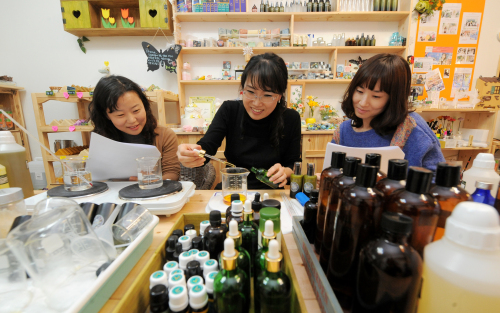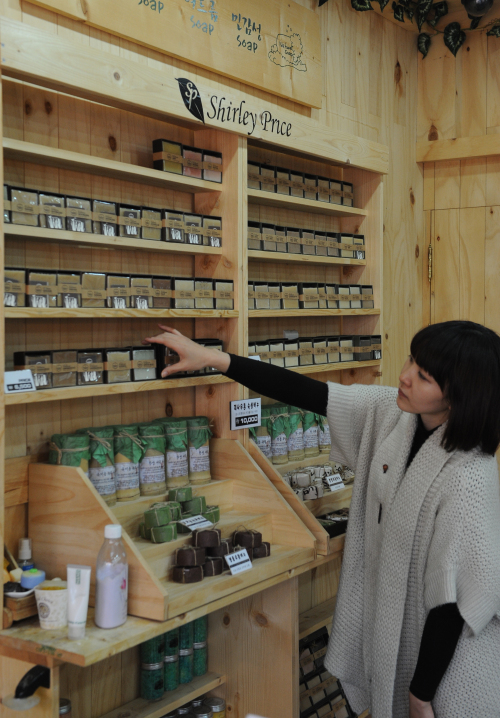
Consumers search for natural, organic cosmetics and some make their own
Fed up with factory-made cosmetics that seemed to cause skin problems, housewife Lee Yu-mi signed up for classes at a natural cosmetics workshop two months ago.
“I have been free of skin troubles ever since I started using the products I made myself,” said Lee at Jullie’s Aroma, a natural cosmetics workshop in Ilsan, Gyeonggi Province.
She and another student were busy making lavender toner and avocado emulsion at the workshop on a Thursday afternoon under the instructor’s supervision. The workshop was more like a lab with all the beakers and boilers, albeit a very fragrant one.
Although it was hard to tell if it was solely due to the change in cosmetic products, Lee’s complexion really was clear even though she was wearing no makeup. The magic didn’t end there for her. She made organic shampoo and allergic rhinitis spray for her husband who had been worrying about hair loss and suffering from rhinitis, and they worked unlike everything he’d tried previously.
“We tried using pricy shampoos sold exclusively at salons for his hair and visited Oriental medicine clinics for his allergies but nothing worked. Hair used to be all over his pillow and he used to sneeze for about 20 to 30 times every morning and evening but ever since he started using the products I made, sneezing and hair loss have stopped,” said Lee.
What did the trick in the case of the rhinitis spray was a single drop of aroma oil in 100 ml of purified water, said the instructor and owner of the workshop Kim Hee-kyung, known as Jullie.
“The quality of the single drop you put in is what matters,” she said.
It is not surprising that people are turning to natural cosmetics, considering the organic craze in food and even apparels and bedding. Cosmetic brands have been rolling out so-called “organic” or “natural” products and professional aromatherapy and natural cosmetics companies and workshops like Jullie’s Aroma have followed.
Each company defines “natural cosmetics” in a different way but what is generally agreed upon is that they should contain no artifical ingredients such as preservatives or surfactants. If more than 95 percent of the ingredients used are organic, then the product can be called organic. Such cosmetics are supposed to be milder to the skin, reduce and prevent skin irritations, allergies and atopic dermatitis and be better for the environment compared to “non-natural” ones.
Fed up with factory-made cosmetics that seemed to cause skin problems, housewife Lee Yu-mi signed up for classes at a natural cosmetics workshop two months ago.
“I have been free of skin troubles ever since I started using the products I made myself,” said Lee at Jullie’s Aroma, a natural cosmetics workshop in Ilsan, Gyeonggi Province.
She and another student were busy making lavender toner and avocado emulsion at the workshop on a Thursday afternoon under the instructor’s supervision. The workshop was more like a lab with all the beakers and boilers, albeit a very fragrant one.
Although it was hard to tell if it was solely due to the change in cosmetic products, Lee’s complexion really was clear even though she was wearing no makeup. The magic didn’t end there for her. She made organic shampoo and allergic rhinitis spray for her husband who had been worrying about hair loss and suffering from rhinitis, and they worked unlike everything he’d tried previously.
“We tried using pricy shampoos sold exclusively at salons for his hair and visited Oriental medicine clinics for his allergies but nothing worked. Hair used to be all over his pillow and he used to sneeze for about 20 to 30 times every morning and evening but ever since he started using the products I made, sneezing and hair loss have stopped,” said Lee.
What did the trick in the case of the rhinitis spray was a single drop of aroma oil in 100 ml of purified water, said the instructor and owner of the workshop Kim Hee-kyung, known as Jullie.
“The quality of the single drop you put in is what matters,” she said.
It is not surprising that people are turning to natural cosmetics, considering the organic craze in food and even apparels and bedding. Cosmetic brands have been rolling out so-called “organic” or “natural” products and professional aromatherapy and natural cosmetics companies and workshops like Jullie’s Aroma have followed.
Each company defines “natural cosmetics” in a different way but what is generally agreed upon is that they should contain no artifical ingredients such as preservatives or surfactants. If more than 95 percent of the ingredients used are organic, then the product can be called organic. Such cosmetics are supposed to be milder to the skin, reduce and prevent skin irritations, allergies and atopic dermatitis and be better for the environment compared to “non-natural” ones.

“Atopic dermatitis patients have increased, among both adults and babies, about 35 percent in the last two years. Besides, it has only been a couple of decades since cosmetic brands have been introduced in Korea, and there is a price bubble. So consumers are turning to natural cosmetic products,” said Wisteria Chang, manager of Marinoel, a natural cosmetics company which opened about two years ago in Cheongpa-dong, central Seoul.
Marinoel not only sells ready-made natural cosmetic goods but also natural ingredients which consumers can use to make their own products. It also runs natural soap making classes in the evening.
“As the weather is getting dryer and colder, customers are asking for cacao soap which helps hydrate and moisturize your skin or chestnut husk soaps that are good for problem skin,” said Chang.
In the case of ready-made “natural” or “organic” products by big name cosmetic companies which produced obviously “non-natural” products before, the question is how natural or organic they really are.
“It can be called ‘natural’ even if it contains only 1 percent natural ingredients,” Kim pointed out.
The range of products that can be made with natural ingredients is surprisingly wide, from lotion and toner to shampoo and air freshener.
It is also possible to make BB creams and sun block but they have to include some chemical ingredients because ingredients that block UV rays or have skin-like tone cannot be found in nature. No matter how strange it sounds, the most popular product these days, said Kim, is breast milk soap.
“Gamma Linolenic acid in breast milk helps skin regeneration. I didn’t know about it until some organic cosmetic-forwards sent their breast milk and asked if I could make soap with it. It takes about 250g of breast milk to make 1kg of soap,” said Kim.
It is usually women in their 20s to 40s who eagerly participate in workshops. They make cosmetic products for themselves and their family. Mothers with children who have atopic dermatitis are commonly found in the classes.
The products are in fact not so difficult to make. They can be made at home with the right tools. Handmade cosmetics make good presents as well because, in the case of soap, they can be “baked up” like cute cup cakes depending on the mold.
Taking into account the price of the ingredients and labor, self-made toners cost about 20,000 won to 45,000 won and creams about 50,000 won. The price is not much cheaper compared to off-the-shelf cosmetic products because the natural ingredients are quite pricy, but “the whole point of natural cosmetic products is to use good ingredients,” said Kim.
One-day classes usually cost about 30,000 won to 50,000 won. Most workshops also run classes through which students can acquire natural cosmetic-making licenses. The licenses are issued by several organizations and such courses vary in price.
It is important to keep in mind that the natural cosmetic products have a very short shelf life. They are good for about three months when kept in the refrigerator and for two months when kept on the dressing table. This fact can be used to verify if a ready-made product that claims to have used only natural ingredients contains chemical preservatives or not, advised Kim.
Blind faith in natural and organic handmade cosmetics, however, should be avoided. They could even be worse than readymade cosmetics when the recipe is incorrect or they are made in an unsanitary way, according to experts.
“It cannot be said that the natural ingredients in natural cosmetic products are safe for all skin types. They can cause skin troubles depending on the individual’s constitution and skin type, so one should check by using a patch test first to see if the ingredient could cause harm before using it,” said Hwang Sun-wook, head of Korea Health Industry Development Institute’s beauty cosmetics team in his book “Cosmetic Products Take After Your Skin” published last month.
“If you want to use a natural or organic product, it is safer to the skin to use those made by an authorized institute under the government’s regulations and quality control. In case of natural cosmetics made at home, easy-to-make ones like natural face packs can be recommended,” he said.
By Park Min-young (claire@heraldcorp.com)
Recipe for lavender toner for dry skin
■ Ingredients
― 2 g lavender herb
― 105 g purified water
― 10 g aloe vera gel
― 1 g hyaluronic acid
― 2 g corn humectant
― 0.5 g acacia collagen
― 0.5 g silk aminosan
― 1 g water argan oil
― 1 g jojoba oil
― 1 g olive liquid
― 5 drops lavendula angustifolia
― 5 drops rose preserve
1. Decoct lavender tea with 2 g lavender herb and 105 g purified water. Do not go over 50 degrees Celsius because it may change the fragrance.
2. Filter it through a coffee filter.
3. Add aloe vera gel, corn humectant, hyaluronic acid to the lavender decoction.
4. Add rest of the ingredients and blend.
5. Stir more with a blender, and then with a spatula. Be careful not to make bubbles.
6. Pour into a sterilized bottle and label.
(Adapted from Jullie’s Aroma recipe)
-
Articles by Korea Herald








![[KH Explains] How should Korea adjust its trade defenses against Chinese EVs?](http://res.heraldm.com/phpwas/restmb_idxmake.php?idx=644&simg=/content/image/2024/04/15/20240415050562_0.jpg&u=20240415144419)











![[Today’s K-pop] Stray Kids to return soon: report](http://res.heraldm.com/phpwas/restmb_idxmake.php?idx=642&simg=/content/image/2024/04/16/20240416050713_0.jpg&u=)